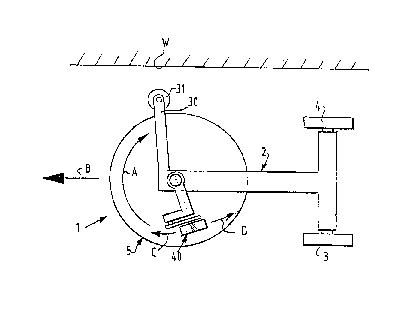Some of the information on this Web page has been provided by external sources. The Government of Canada is not responsible for the accuracy, reliability or currency of the information supplied by external sources. Users wishing to rely upon this information should consult directly with the source of the information. Content provided by external sources is not subject to official languages, privacy and accessibility requirements.
Any discrepancies in the text and image of the Claims and Abstract are due to differing posting times. Text of the Claims and Abstract are posted:
| (12) Patent: | (11) CA 2194949 |
|---|---|
| (54) English Title: | AN APPARATUS FOR PROCESSING A SURFACE WITH A ROTATING MEMBER |
| (54) French Title: | APPAREIL DE TRAITEMENT D'UNE BASE A L'AIDE D'UN ELEMENT ROTATIF |
| Status: | Expired and beyond the Period of Reversal |
| (51) International Patent Classification (IPC): |
|
|---|---|
| (72) Inventors : |
|
| (73) Owners : |
|
| (71) Applicants : |
|
| (74) Agent: | BERESKIN & PARR LLP/S.E.N.C.R.L.,S.R.L. |
| (74) Associate agent: | |
| (45) Issued: | 2001-03-13 |
| (22) Filed Date: | 1997-01-13 |
| (41) Open to Public Inspection: | 1997-08-09 |
| Examination requested: | 1997-09-11 |
| Availability of licence: | N/A |
| Dedicated to the Public: | N/A |
| (25) Language of filing: | English |
| Patent Cooperation Treaty (PCT): | No |
|---|
| (30) Application Priority Data: | ||||||
|---|---|---|---|---|---|---|
|
An apparatus for processing a surface with the aid of a
rotating member, such as brushing or rubbing a floor,
comprising:
- a frame or chassis;
- coupling means disposed on the chassis and for
coupling the rotating member to the chassis;
- driving means displaced in the chassis and for
driving the rotating member; and
- varying means for varying the magnitude and position
of the pressing force of the rotating member relative
to the surface.
Note: Claims are shown in the official language in which they were submitted.
Note: Descriptions are shown in the official language in which they were submitted.

2024-08-01:As part of the Next Generation Patents (NGP) transition, the Canadian Patents Database (CPD) now contains a more detailed Event History, which replicates the Event Log of our new back-office solution.
Please note that "Inactive:" events refers to events no longer in use in our new back-office solution.
For a clearer understanding of the status of the application/patent presented on this page, the site Disclaimer , as well as the definitions for Patent , Event History , Maintenance Fee and Payment History should be consulted.
| Description | Date |
|---|---|
| Inactive: IPC expired | 2024-01-01 |
| Time Limit for Reversal Expired | 2010-01-13 |
| Letter Sent | 2009-01-13 |
| Inactive: IPC from MCD | 2006-03-12 |
| Letter Sent | 2003-09-05 |
| Letter Sent | 2003-09-05 |
| Letter Sent | 2003-09-05 |
| Grant by Issuance | 2001-03-13 |
| Inactive: Cover page published | 2001-03-12 |
| Pre-grant | 2000-12-07 |
| Inactive: Final fee received | 2000-12-07 |
| Letter Sent | 2000-07-06 |
| Notice of Allowance is Issued | 2000-07-06 |
| Notice of Allowance is Issued | 2000-07-06 |
| Inactive: Approved for allowance (AFA) | 2000-06-13 |
| Amendment Received - Voluntary Amendment | 2000-05-16 |
| Inactive: S.30(2) Rules - Examiner requisition | 1999-11-22 |
| Amendment Received - Voluntary Amendment | 1998-07-08 |
| Inactive: Application prosecuted on TS as of Log entry date | 1998-03-18 |
| Letter Sent | 1998-03-18 |
| Inactive: Status info is complete as of Log entry date | 1998-03-18 |
| All Requirements for Examination Determined Compliant | 1997-09-11 |
| Request for Examination Requirements Determined Compliant | 1997-09-11 |
| Application Published (Open to Public Inspection) | 1997-08-09 |
There is no abandonment history.
The last payment was received on 2000-12-15
Note : If the full payment has not been received on or before the date indicated, a further fee may be required which may be one of the following
Patent fees are adjusted on the 1st of January every year. The amounts above are the current amounts if received by December 31 of the current year.
Please refer to the CIPO
Patent Fees
web page to see all current fee amounts.
| Fee Type | Anniversary Year | Due Date | Paid Date |
|---|---|---|---|
| Registration of a document | 1997-02-18 | ||
| Request for examination - standard | 1997-09-11 | ||
| MF (application, 2nd anniv.) - standard | 02 | 1999-01-13 | 1998-12-15 |
| MF (application, 3rd anniv.) - standard | 03 | 2000-01-13 | 1999-12-16 |
| Final fee - standard | 2000-12-07 | ||
| MF (application, 4th anniv.) - standard | 04 | 2001-01-15 | 2000-12-15 |
| MF (patent, 5th anniv.) - standard | 2002-01-14 | 2001-12-12 | |
| MF (patent, 6th anniv.) - standard | 2003-01-13 | 2002-12-19 | |
| Registration of a document | 2003-07-31 | ||
| MF (patent, 7th anniv.) - standard | 2004-01-13 | 2003-12-22 | |
| MF (patent, 8th anniv.) - standard | 2005-01-13 | 2004-12-21 | |
| MF (patent, 9th anniv.) - standard | 2006-01-13 | 2005-12-30 | |
| MF (patent, 10th anniv.) - standard | 2007-01-15 | 2006-12-20 | |
| MF (patent, 11th anniv.) - standard | 2008-01-14 | 2007-12-18 |
Note: Records showing the ownership history in alphabetical order.
| Current Owners on Record |
|---|
| UNILEVER PLC |
| JOHNSONDIVERSEY, INC. |
| Past Owners on Record |
|---|
| DIETER WINDMEISSER |